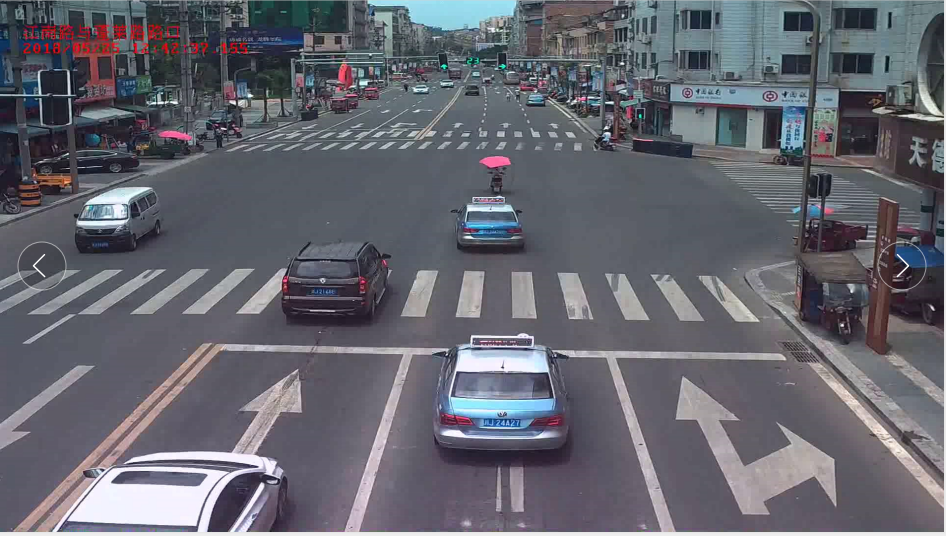第十三周周总结
2020.05.16
本周完成了视频中截取帧图篇,并识别图片中车牌号的功能。
识别基本思路:先是车牌提取,识别图中车牌位置并保存车牌图片(流程:高斯去噪、灰度处理、sobel边缘检测、自适应阈值处理、闭运算、中值滤波去除噪点、轮廓绘制、遍历所有轮廓,去除车牌(车牌 宽>2倍高、为了识别准确,只识别靠近摄像头的车牌号,远处车牌号太不清楚,选择y>500,x<1250、轮廓宽<100 并且>50))
1 2 3 4 5 6 7 8 9 10 11 12 13 14 15 16 17 18 19 20 21 22 23 24 25 26 27 28 29 30 31 32 33 34 35 36 37 38 39 40 41 42 43 44 45 46 47 48 49 50 51 52 53 54 55 56 57 58 59 60 61 62 63 64 65 66 67 68 69 70 71 72 73 74 75 76 77 78 79 80 81 82 83 84 85 86 87 88 89 90 91 | # 导入所需模块import cv2from matplotlib import pyplot as pltdef cp_tiqu(name): # 加载图片 rawImage = cv2.imread(name) # plt_show0('yuantu',rawImage) # 高斯去噪 image = cv2.GaussianBlur(rawImage, (3, 3), 0) # 预览效果 # plt_show0('GaussianBlur',image) # 灰度处理 gray_image = cv2.cvtColor(image, cv2.COLOR_RGB2GRAY) plt_show('COLOR_RGB2GRAY', gray_image) # sobel算子边缘检测(做了一个y方向的检测) Sobel_x = cv2.Sobel(gray_image, cv2.CV_16S, 1, 0) # Sobel_y = cv2.Sobel(image, cv2.CV_16S, 0, 1) absX = cv2.convertScaleAbs(Sobel_x) # 转回uint8 # absY = cv2.convertScaleAbs(Sobel_y) # dst = cv2.addWeighted(absX, 0.5, absY, 0.5, 0) image = absX plt_show('Sobel bianyuan', image) # 自适应阈值处理 ret, image = cv2.threshold(image, 0, 255, cv2.THRESH_OTSU) plt_show('threshold yuzhi', image) # 闭运算,是白色部分练成整体 kernelX = cv2.getStructuringElement(cv2.MORPH_RECT, (3, 3)) print(kernelX) image = cv2.morphologyEx(image, cv2.MORPH_CLOSE, kernelX, iterations=2) plt_show('biyunsuan', image) # 去除一些小的白点 kernelX = cv2.getStructuringElement(cv2.MORPH_RECT, (20, 1)) kernelY = cv2.getStructuringElement(cv2.MORPH_RECT, (1, 19)) ''' # 膨胀,腐蚀 image = cv2.dilate(image, kernelX) image = cv2.erode(image, kernelX) # 腐蚀,膨胀 image = cv2.erode(image, kernelY) image = cv2.dilate(image, kernelY) plt_show('pengzhangfushi',image) ''' # 中值滤波去除噪点 image = cv2.medianBlur(image, 15) plt_show('chu zao', image) # 轮廓检测 # cv2.RETR_EXTERNAL表示只检测外轮廓 # cv2.CHAIN_APPROX_SIMPLE压缩水平方向,垂直方向,对角线方向的元素,只保留该方向的终点坐标,例如一个矩形轮廓只需4个点来保存轮廓信息 contours, hierarchy = cv2.findContours(image, cv2.RETR_EXTERNAL, cv2.CHAIN_APPROX_SIMPLE) # 绘制轮廓 image1 = rawImage.copy() cv2.drawContours(image1, contours, -1, (0, 255, 0), 5) plt_show0('lunkuo', image1) # 筛选出车牌位置的轮廓 # 这里我只做了一个车牌的长宽比在3:1到4:1之间这样一个判断 num = 1 for item in contours: # cv2.boundingRect用一个最小的矩形,把找到的形状包起来 rect = cv2.boundingRect(item) x = rect[0] y = rect[1] weight = rect[2] height = rect[3] # 440mm×140mm # if (weight > (height * 3)) and (weight < (height * 4)) and y > 500: if (weight > (height * 2)) and y > 500 and x < 1250 and weight < 100 and weight > 50: image = rawImage[y:y + height, x:x + weight] # cv_show('image',image) # 图像保存 image_name = 'car' + str(num) + '.jpg' print(image_name) plt_show0('save', image) cv2.imwrite(image_name, image) num += 1if __name__ == '__main__': cp_tiqu("120.jpg") |
原图:

获取车牌图片信息:


第二步:将车牌图篇分割为一个个字符图片
思路:高斯去噪、灰度处理、自适应阈值、计算二值、轮廓绘制、筛选各个字符位置的轮廓
1 2 3 4 5 6 7 8 9 10 11 12 13 14 15 16 17 18 19 20 21 22 23 24 25 26 27 28 29 30 31 32 33 34 35 36 37 38 39 40 41 42 43 44 45 46 47 48 49 50 51 52 53 54 55 56 57 58 59 60 61 62 63 64 65 66 67 68 69 70 71 | # 导入所需模块import cv2from matplotlib import pyplot as pltdef zifu_tiqu(name): # 加载图片 rawImage = cv2.imread(name) plt_show0('yuantu', rawImage) # 高斯去噪 image = cv2.GaussianBlur(rawImage, (3, 3), 0) # 预览效果 plt_show0('GaussianBlur', image) # 灰度处理 gray_image = cv2.cvtColor(image, cv2.COLOR_RGB2GRAY) plt_show('gray image', gray_image) # 自适应阈值处理 ret, image = cv2.threshold(gray_image, 0, 255, cv2.THRESH_OTSU) plt_show('yuzhi', image) # 计算二值图像黑白点的个数,处理绿牌照问题,让车牌号码始终为白色 area_white = 0 area_black = 0 height, width = image.shape print(image.shape) for i in range(height): for j in range(width): if image[i, j] == 255: area_white += 1 else: area_black += 1 #if area_white > area_black: # ret, image = cv2.threshold(gray_image, 0, 255, cv2.THRESH_OTSU | cv2.THRESH_BINARY_INV) #plt_show('erzhi', image) kernel = cv2.getStructuringElement(cv2.MORPH_RECT, (1, 1)) contours, hierarchy = cv2.findContours(image, cv2.RETR_EXTERNAL, cv2.CHAIN_APPROX_SIMPLE) # 绘制轮廓 image1 = rawImage.copy() cv2.drawContours(image1, contours, -1, (0, 255, 0), 1) plt_show0('lun kuo', image1) # 筛选出各个字符的位置的轮廓 words = [] for item in contours: # cv2.boundingRect用一个最小的矩形,把找到的形状包起来 word = [] rect = cv2.boundingRect(item) x = rect[0] y = rect[1] weight = rect[2] height = rect[3] word.append(x) word.append(y) word.append(weight) word.append(height) words.append(word) words = sorted(words, key=lambda s: s[0], reverse=False) print(words) i = 0 for word in words: if (word[3] > (word[2])) and (word[3] < (word[2] * 5)): i = i + 1 image = rawImage[word[1]:word[1] + word[3], word[0]:word[0] + word[2]] plt_show0('single', image) print('test2_' + str(i) + '.jpg') cv2.imwrite('chepai/test2_' + str(i) + '.jpg', image |




【推荐】编程新体验,更懂你的AI,立即体验豆包MarsCode编程助手
【推荐】凌霞软件回馈社区,博客园 & 1Panel & Halo 联合会员上线
【推荐】抖音旗下AI助手豆包,你的智能百科全书,全免费不限次数
【推荐】博客园社区专享云产品让利特惠,阿里云新客6.5折上折
【推荐】轻量又高性能的 SSH 工具 IShell:AI 加持,快人一步
· DeepSeek 解答了困扰我五年的技术问题
· 为什么说在企业级应用开发中,后端往往是效率杀手?
· 用 C# 插值字符串处理器写一个 sscanf
· Java 中堆内存和栈内存上的数据分布和特点
· 开发中对象命名的一点思考
· PPT革命!DeepSeek+Kimi=N小时工作5分钟完成?
· What?废柴, 还在本地部署DeepSeek吗?Are you kidding?
· DeepSeek企业级部署实战指南:从服务器选型到Dify私有化落地
· 程序员转型AI:行业分析
· 重磅发布!DeepSeek 微调秘籍揭秘,一键解锁升级版全家桶,AI 玩家必备神器!